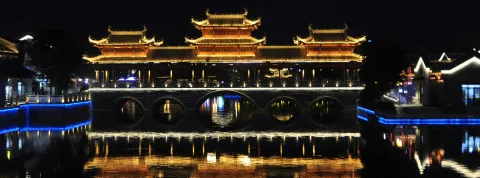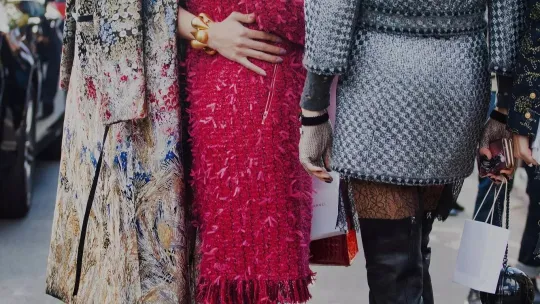
Luxury in China: opportunities and challenges for international brands
Luxury in China: opportunities and challenges for international brandsWith a growing middle class and a large number of affluent consumers, China is one of the biggest markets for luxury goods. Before the pandemic, Chinese consumers were even the biggest spenders on luxury goods, contributing to a quarter of global sales. What's more, a significant proportion of these purchases were made abroad, particularly in Europe. A key market, rich in opportunities, but also full of challenges for international brands.
China, a key player in the global luxury market
Key figures and weight of the luxury goods market in China
With more than 1.4 billion inhabitants and a rapidly expanding middle class, China has become a strategic pillar for the major luxury brands. In 2023, according to Bain & Company, China accounted for nearly 25% of global sales of luxury goods, a figure that could rise to 40% by 2030 if the momentum continues.
Chinese consumers are among the world's biggest spenders in this sector. Their purchases are no longer limited to trips to Paris or Milan: for several years now, local consumption has been exploding, encouraged by policies to repatriate spending (reduction in import taxes, development of duty-free zones such as Hainan, etc.).
Groups such as LVMH, Kering and Hermès now generate a significant proportion of their sales in mainland China, to the point where this market has become a strategic compass for product launches, marketing campaigns and retail innovation.
Transformation of consumption habits after the health crisis
The Covid-19 pandemic put the brakes on global consumption, particularly in China, for over a year. But while the Chinese market was initially shaken by the confinements, it was also the first to pick up again, revealing a profound change in purchasing behaviour.
On the one hand, luxury spending is being relocated. Unable to travel, consumers have begun to buy directly in the country, in local boutiques or via high-end digital platforms. This structural change continued even after the restrictions were lifted.
On the other hand, the crisis has reinforced new expectations: authenticity, sustainability, personalisation. The younger generations - millennials and Gen Z - are taking over, with a more emotional and committed approach to luxury. Like their Western counterparts, their purchasing decisions are increasingly influenced by societal values and the quest for meaning, as well as customer experience and technological innovation (augmented reality, live shopping, etc.).
For international brands, this means constantly adapting their product offering, distribution channels and communications, which must incorporate Chinese cultural codes without betraying the brand's DNA.
Digitalisation and influencers: the new pillars of luxury in China
The role of Chinese influencers in brand strategies
In a market as vast as it is dynamic, Chinese influencers now play a central role in luxury consumption. Whether they are celebrities, KOLs (Key Opinion Leaders) or KOCs (Key Opinion Consumers), they shape tastes, guide purchasing choices and create an unprecedented closeness between brands and new consumers.
The major fashion houses are no longer content with traditional advertising campaigns: they are collaborating with influential figures such as Mr. Bags, Austin Li or Angelababy to launch exclusive collections, generate viral content or create immersive experiences. These collaborations help to translate the world of luxury into a culturally appropriate language, and above all to engage a young, connected and demanding audience.
In China, influence is based not just on prestige, but on perceived authenticity, the ability to tell a story and embody values. This is profoundly transforming the codes of luxury communications, a far cry from the “old-fashioned” habits of the past.
The essential digital platforms for luxury in China
The digitalisation of luxury in China cannot be summed up by a simple e-commerce site. It is based on a digital ecosystem that is unique in the world, where each platform has its own codes, uses and influencers.
Among the key players:
WeChat, a veritable super-app, is used for everything: communication, payment, e-commerce and CRM. Brands use it to create mini-programmes for immersive shopping experiences.
Xiaohongshu (Little Red Book) is the favourite network for young consumers to discover products, read authentic reviews or follow the recommendations of Chinese influencers.
Tmall Luxury Pavilion, Alibaba's high-end showcase, enables ultra-targeted distribution with a premium environment, integrated into the Chinese digital universe.
Douyin, the local version of TikTok, has become a major channel for live shopping, viral campaigns and real-time product launches.
For those who want to understand the global challenges facing the sector, decipher new trends such as the digitalisation of luxury goods in China, and evolve in multicultural environments, the MBA Global Luxury Brand Management offered by Sup de Luxe offers a comprehensive, international training programme focused on the realities on the ground.
This top-quality programme, taught in English, trains future experts in luxury brand management through cutting-edge courses, meetings with industry professionals and practical, high added-value projects.
New Chinese consumers: profiles and expectations
The rise of the younger generation and ultra-connected consumers
In China, the new dynamics of luxury consumption are largely driven by millennials (born between 1980 and 1995) and generation Z (born after 1995). These younger generations, born with the country's economic growth, are very familiar with social networks and have a marked taste for prestige brands.
Hyper-connected, they navigate daily between social platforms, e-commerce sites and immersive content. For these ultra-connected consumers, luxury is more than just a product: it is a lifestyle that is built online, shared, displayed and told.
These young adults expect a consistent experience across all channels: from storytelling on Douyin to smooth shopping on Tmall Luxury Pavilion and personalised customer service on WeChat. In this way, digital is becoming as powerful a driver of customer loyalty as the quality of the product itself.
The boom in sustainable and responsible luxury in China
Another major development is the rise of sustainable luxury. Long seen as a market sensitive to prestige and image, the Chinese market is moving towards more responsible consumption, particularly among the younger generations.
The new Chinese consumers are now paying close attention to the commitments made by brands: the origin of raw materials, respect for the environment, production conditions, transparency in the value chain, etc. These are all criteria that play a part in their purchasing decisions.
This trend is prompting luxury brands to incorporate ethical practices and make them a strategic communications focus. Campaigns highlighting the eco-design of products, the use of recycled materials and CSR initiatives are increasingly popular on Chinese social networks.
In China, as elsewhere, the luxury of tomorrow will undoubtedly be more sustainable, more sincere, and more attuned to society's expectations. For international brands, it is no longer just a question of seducing, but of making a commitment with authenticity.
Challenges and prospects for luxury brands in China
An increasingly selective and demanding market
While China remains a land of opportunity for luxury brands, it has also become a particularly selective market, where brand awareness is no longer enough. Chinese consumers, who are better informed and more mature, compare and analyse, and expect brands to live up to their promises.
The upmarket nature of the local offer, the proliferation of new collaborations and the emergence of premium Chinese brands are changing the game. Luxury can no longer rely on historical prestige: it must constantly reinvent itself, adapting to cultural expectations and offering an experience that is both exclusive and relevant.
In this context, the strategy of international brands must be refined, targeted and personalised. This requires a strong local presence, teams dedicated to the Chinese market, constant monitoring and the ability to anticipate rapid changes in consumer behaviour.
The challenge of authenticity and the fight against counterfeiting
Among the persistent challenges, counterfeiting remains particularly acute. Although China has strengthened its legal arsenal in terms of intellectual property, the parallel market remains significant, particularly on certain online platforms or via informal resale channels.
For luxury brands, the battle is twofold: they need to protect their image and guarantee their customers an authentic, flawless experience. Product traceability, digital certificates of authenticity and blockchain-based solutions are developing rapidly to meet these expectations.
But beyond technology, the real issue is trust. The new Chinese consumers want to be sure that what they are buying is in line with the values that the brand claims. Authenticity is becoming as important a criterion as design or prestige.
Along with India, China still has the world's largest population, and the largest luxury customer base. Despite recent turbulence (Covid, the property crisis, US taxes, etc.), the future of luxury in the country remains promising. But brands must continue to create strong emotional bonds. Those that are able to adapt to this new reality will continue to grow in the world's largest market. The question is not whether Chinese consumers still want luxury, but whether luxury brands are prepared to offer them what they really want.

